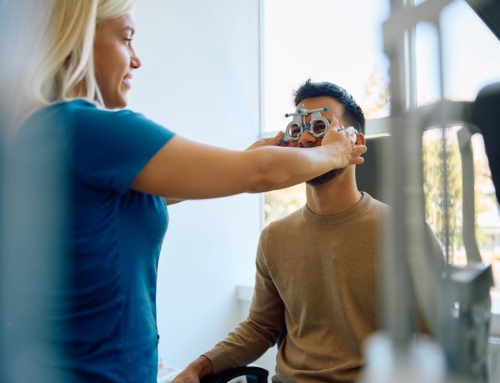In today’s always-on world, our eyes rarely get a break. Between work emails, streaming shows, and scrolling through social media, digital screens have become nearly impossible to avoid. Many people assume that tired or achy eyes are simply a result of a long day, but sometimes what feels like ordinary fatigue could be a sign of something more. Recognizing the symptoms of eye strain and understanding their possible causes can help you take better care of your vision and know when it’s time for an eye exam.
What Is Eye Strain?
Eye strain occurs when the eyes become overworked due to extended use. Common triggers include reading in poor lighting, spending hours in front of digital screens, or performing visually demanding tasks without adequate breaks. While eye strain itself isn’t typically dangerous, persistent or severe symptoms can interfere with daily comfort and may even point to underlying vision problems.
Eye strain is common for children nowadays, especially for those engaged in remote learning or recreational screen time. Because children’s visual systems are still developing, prolonged focus on screens can lead to discomfort and reduced concentration, which are signs that their eyes may be working harder than they should.
Recognizing the Symptoms
Eye strain can appear in several forms, and its symptoms often overlap with general fatigue. The most common signs include:
- Headaches: A dull ache around the eyes or temples can develop after long periods of close work or screen exposure.
- Blurred or double vision: You might notice that text becomes harder to focus on or that your vision fluctuates when shifting from near to far distances.
- Dryness or irritation: Staring at screens often reduces blink rate, leading to dryness, burning, or a gritty feeling.
- Light sensitivity: Bright lights or glare from screens and sunlight may feel unusually harsh.
- Difficulty focusing: Switching your gaze between tasks, such as from a computer monitor to printed notes, can become more challenging.
While these symptoms are often temporary, persistent or worsening discomfort shouldn’t be ignored. If you experience recurring eye strain, it’s worth scheduling an eye exam to ensure there isn’t a deeper issue at play, such as an outdated prescription or an uncorrected focusing imbalance.
Why Eye Strain Happens
Several factors can contribute to eye strain, often working together:
- Screen time and blue light exposure: Continuous focus on screens forces the eyes to maintain a close viewing distance, which can fatigue the focusing muscles.
- Poor posture and ergonomics: Viewing screens at awkward angles or working in dim light can increase strain on both eyes and neck muscles.
- Uncorrected vision problems: Nearsightedness, farsightedness, or astigmatism can make tasks like reading or computer work harder on the eyes if not properly corrected.
- Environmental factors: Dry indoor air, glare, or overly bright lighting can aggravate symptoms.
Fortunately, there are practical ways to reduce eye strain, even for those who spend much of their day in front of screens.
Everyday Strategies for Relief
One of the most well-known approaches is the 20-20-20 rule, which encourages taking a 20-second break every 20 minutes to look at something 20 feet away. The 20-20-20 rule helps lessen eye strain by giving your eye muscles a chance to relax and refocus.
Other helpful tips include:
- Adjusting screen brightness and contrast to match ambient light levels.
- Blinking frequently to maintain natural moisture.
- Positioning screens properly, ideally at an arm’s length and slightly below eye level.
- Using appropriate lighting, avoiding glare or direct reflections.
If discomfort persists even after adopting these habits, it’s a sign that further evaluation may be needed.
When to Seek Professional Help
Sometimes, eye strain signals an underlying issue that simple adjustments can’t fix. Conditions like presbyopia (age-related difficulty focusing on near objects) or subtle prescription changes can all contribute to eye fatigue.
That’s why regular eye exams are so important. They help detect not only changes in vision but also early signs of more serious conditions. An eye care professional can recommend personalized solutions, such as updated lenses, blue light protection, or task-specific eyewear designed for computer or reading use.
When choosing the right eye professional for your eye-related problems, consider factors such as credentials, experience, and whether they specialize in visual correction or ocular health. Building a relationship with a trusted eye professional ensures you receive care tailored to your needs.
Our eyes are remarkably resilient, but they also deserve regular care and attention. By learning to recognize the warning signs of eye strain and knowing when to seek professional input, you can protect your visual comfort and overall well-being. Taking care of your eyes is all about maintaining clear, comfortable vision for years to come.




